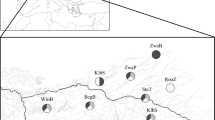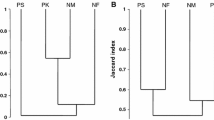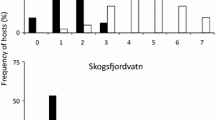Abstract
Both biotic and abiotic factors have been invoked to explain the large variations observed in the prevalence and abundance of parasites in aquatic ecosystems. However, we have only a poor knowledge of the potential interplay among these factors in natural systems. It is, therefore, important to analyze the effects of multiple potential environmental drivers together to get an integrated view of their influence on the prevalence and abundance of parasites. To this end, we selected two genera of digenean trematode parasites that require at least two hosts to complete their life cycle and use two different transmission strategies. Crepidostomum moves through a trophic pathway via consumption of infected prey by the host, while Apophallus infects its hosts via direct penetration of their skin. This study was conducted in 23 Canadian Shield lakes exhibiting orthogonal gradients of biotic (fish species richness and biomass) and abiotic (morphometry, physico-chemical) variables. We quantified prevalence and abundance of these parasites in the skin and intestine of brook charr (Salvelinus fontinalis). Our results show that biotic factors are key drivers of parasite abundance and prevalence, with Apophallus being negatively associated with the fish species richness–biomass gradient, and Crepidostomum responding more to identity of host than to the diversity gradient. Among the abiotic variables, lake area was found to be positively related to both prevalence and abundance in Apophallus. Our results suggest that taking into account the interplay of both biotic and abiotic factors is crucial for understanding patterns of parasite transmission success in boreal lakes.





Similar content being viewed by others
References
Allan BF, Keesing F, Ostfeld RS (2003) Effect of forest fragmentation on Lyme disease risk. Conserv Biol 17:267–272
Arneberg P, Skorping A, Grenfell B, Read AF (1998) Host densities as determinants of abundance in parasite communities. Proc R Soc B Biol Sci 265:1283–1289
Bates D, Maechler M, Bolker B, Walker S (2015) Fitting linear mixed-effects models using lme4. Stat Softw 67:1–48
Bergeron M, Marcogliese DJ, Magnan P (1997) The parasite fauna of brook trout, Salvelinus fontinalis (Mitchill), in relation to lake morphometrics and the introduction of creek chub, Semotilus atromaculatus (Mitchill). Écoscience 4:427–436
Bertrand M, Marcogliese DJ, Magnan P (2008) Trophic polymorphism in brook charr revealed by diet, parasites and morphometrics. J Fish Biol 72:555–572
Bourke P, Magnan P, Rodriguez MA (1999) Phenotypic responses of lacustrine brook charr in relation to the intensity of interspecific competition. Evol Ecol 13:19–31
Brownstein JS, Skelly DK, Holford TR, Fish D (2005) Forest fragmentation predicts local scale heterogeneity of Lyme disease risk. Oecologia 146:469–475
Buck JC, Lutterschmidt WI (2017) Parasite abundance decreases with host density: evidence of the encounter-dilution effect for a parasite with a complex life cycle. Hydrobiologia 784:201–210
Burnham KP, Anderson DR (2002) Model selection and multimodel inference: a practical information-theoretic approach, 2nd edn. Springer, New York, p 515
Calhoun DM, McDevitt-Galles T, Johnson PTJ (2018) Parasites of invasive freshwater fishes and the factors affecting their richness. Freshw Sci 37:134–146
Conn DB, Babapulle MN, Klein KA, Rosen DA (1994) Invading the invaders: infestation of zebra mussel by native parasites of the St. Lawrence river. In: Proceedings of the fourth international zebra mussel conference, Madison, Wisconsin pp 515–523
Des Clers S (1991) Functional relationship between Sealworm (Pseudoterranova decipiens, Nematoda, Ascaridoidea) burden and host size in Atlantic Cod (Gadus morhua). Proc R Soc B Biol Sci 245:85–89
Desgranges JL, Darveau M (1985) Effect of lake acidity and morphometry on the distribution of aquatic birds in southern Quebec, Canada. Holarct Ecol 8:181–190
Dogiel VA, Petrushevskii GK, Polyanski YI (1958) Parasitology of fishes. Leningrad University Press, Saint Petersburg (in Russian; English translation: Olivier & Boyd, London, 1961)
Dubois N, Marcogliese DJ, Magnan P (1996) Effects of the introduction of white sucker, Catostomus commersoni, on the parasite fauna of brook trout, Salvelinus fontinalis. Can J Zool 74:1304–1312
Dupuch A, Bertolo A, Magnan P, Dill LM (2014) Indirect effects of asymmetrical competition among top predators determine spatial patterns of predation risk for prey. Aquat Sci 76:543–552
Fournier DA, Skaug HJ, Ancheta J, Ianelli J, Magnusson A, Maunder M, Nielsen A, Sibert J (2012) AD model builder: using automatic differentiation for statistical inference of highly parameterized complex nonlinear models. Optim Methods Softw 27:233–249
Franz M, Kramer-Schadt S, Greenwood AD, Courtiol A (2018) Sickness-induced lethargy can increase host contact rates and pathogen spread in water-limited landscapes. Funct Ecol 32:2194–2204
Giraudoux P, Craig PS, Delattre P, Bao G, Bartholomot B, Harraga S, Quéré JP, Raoul F, Wang Y, Shi D, Vuitton D (2003) Interactions between landscape changes and host communities can regulate Echinococcus multilocularis transmission. Parasitology 127:121–131
Gorham E (1964) Morphometric control of annual heat budget in temperate lakes. Limnol Oceanogr 9:525–529
Grutter AS, Poulin R (1998) Intraspecific and interspecific relationships between host size and the abundance of parasitic larval gnathiid isopods on coral reef fishes. Mar Ecol Prog Ser 164:263–271
Guillemette F, del Giorgio PA (2011) Reconstructing the various facets of dissolved organic carbon bioavailability in freshwater ecosystems. Limnol Oceanogr 56:734–748
Hartvisgen R, Kennedy CR (1993) Patterns in the composition and richness of helminth communities in brown trout, Salmo trutta, in a group of reservoirs. J Fish Biol 43:603–615
Hatcher MJ, Dick JT, Dunn AM (2012) Diverse effects of parasites in ecosystems: linking interdependent processes. Front Ecol Environ 10:186–194
Hoffman GL (1999) Parasites of North American freshwater fishes, 2nd edn. Cornell University Press, Ithaca
Hopkins SR, Ocampo JM, Wojdak JM, Belden LK (2016) Host community composition and defensive symbionts determine trematode parasite abundance in host communities. Ecosphere 7(3):e01278
Johnson PTJ, Thieltges DW (2010) Diversity, decoys and the dilution effect: how ecological communities affect disease risk. J Exp Biol 213:961–970
Johnson PTJ, Preston DL, Hoverman JT, LaFonte BE (2013) Host and parasite diversity jointly regulate pathogen transmission in complex communities. Proc Natl Acad Sci 110:16916–16921
Johnson PTJ, Wood CL, Joseph MB, Preston DL, Haas SE, Springer YP (2016) Habitat heterogeneity drives the host diversity-begets-parasite diversity relationship: evidence from experimental and field studies. Ecol Lett 19:752–761
Keesing F, Holt RD, Ostfeld RS (2006) Effect of species diversity on disease risk. Ecol Lett 9:485–498
Kelly DW, Paterson RA, Townsend CR, Poulin R, Thompkins DM (2009) Has the introduction of brown trout altered disease patterns in native New Zealand fish? Freshw Biol 54:1805–1818
Kennedy CR, Burrough RJ (1978) Parasites of trout and perch in Malham Tarn. Field Stud J 4:617–629
Krakau M, Thieltges DW, Reise K (2006) Native parasites adopt introduced bivalves of the North Sea. Biol Invasion 8:919–925
Kroeker KJ, Kordas RL, Crim RN, Singh GG (2010) Meta-analysis reveals negative yet variable effects of ocean acidification on marine organisms. Ecol Lett 13:1419–1434
Lachance S, Magnan P (1990a) Performance of domestic, hybrid and wild strains of brook trout, Salvelinus fontinalis, after stocking: the impact of intra- and interspecific competition. Can J Fish Aquat Sci 47:2278–2284
Lachance S, Magnan P (1990b) Comparative ecology and reproductive potential of wild, domestic and hybrid strains of brook trout, Salvelinus fontinalis, after stocking. Can J Fish Aquat Sci 47:2285–2292
Lafferty KD (2008) Ecosystem consequences of fish parasites. J Fish Biol 73:2083–2093
Lafferty KD, Allesina S, Arim M, Briggs CJ, De Leo G, Dobson AP, Dunne JA, Johnson PTJ, Kuris AM, Marcogliese DJ, Martinez ND, Memmott J, Marquet PA, McLaughlin JP, Mordecai EA, Pascual M, Poulin R, Thieltges DW (2008) Parasites in food webs: the ultimate missing links. Ecol Lett 11:533–546
Lagrue C, Poulin R (2015) Bottom-up regulation of parasite population densities in freshwater ecosystems. Oikos 124:1639–1647
LoGiudice K, Ostfeld RS, Schmidt KA, Keesing F (2003) The ecology of infectious disease: effects of host diversity and community composition on Lyme disease risk. Proc Natl Acad Sci 100:567–571
MacArthur RH, Wilson EO (1967) The theory of island biogeography. Princeton University Press, Princeton
MacLeod CD, Poulin R (2012) Host-parasite interactions: a litmus test for ocean acidification? Trends Parasitol 28:365–369
Magnan P (1988) Interactions between brook charr, Salvelinus fontinalis, and nonsalmonid species: ecological shift, morphological shift, and their impact on zooplankton communities. Can J Fish Aquat Sci 45:999–1009
Marcogliese DJ, Cone DK (1991) Importance of lake characteristics in structuring parasite communities of salmonids from insular Newfoundland. Can J Zool 69:2962–2967
Marcogliese DJ, Cone DK (1997) Parasite communities as indicators of ecosystem stress. Parassitologia 39:227–232
Margolis L, Arthur JR (1979) Synopsis of the parasites of fishes of Canada. Bulletin of the Fisheries Research Board of Canada. Bulletin 199
Masse D (2000) Le plongeon huard (Gavia immer) sous surveillance en Mauricie. Le Naturaliste canadien 124:22–26
Morris DP, Zagarese H, Williamson CE, Balseiro EG, Hargreaves BR, Modenutti B, Moeller R, Queimalinos C (1995) The attenuation of solar UV radiation in lakes and the role of dissolved organic carbon. Limnol Oceanogr 40:1381–1391
Neilsen LA, Johnson DL (1983) Fisheries techniques. American Fisheries Society, Maryland
Oksanen J, Blanchet FG, Friendly M, Kindt R, Legendre P, McGlinn D, Minchin PT et al (2016) Vegan: community ecology package. R package version 2.4-1
Orlofske SA, Jadin RC, Preston DL, Johnson PTJ (2012) Parasite transmission in complex communities: predators and alternative hosts alter pathogenic infections in amphibians. Ecology 93:1247–1253
Österling ME (2011) Test and application of a non-destructive photo-method investigating the parasitic stage of the threatened mussel Margarifitera margarifitera on its host fish Salmo trutta. Biol Conserv 144:2984–2990
Ostfeld RS, Glass GE, Keesing F (2005) Spatial epidemiology: an emerging (or re-emerging) discipline. Trends Ecol Evol 20:328–336
Persson L (1985) Asymmetrical competition: are larger animals competitively superior? Am Nat 126:261–266
Pietrock M, Marcogliese DJ (2003) Free-living endohelminth stages: at the mercy of environmental conditions. Trends Parasitol 19:293–299
Pitre HN, Boyd FJ (1970) A study of the role of weeds in corn fields in the epidemiology of corn stunt disease. J Econ Entomol 63:195–197
Power G (1980) The brook charr, Salvelinus fontinalis. In: Balon EK (ed) Charrs: salmonid fishes of the genus Salvelinus. Dr. W. Junk. Bv Publishers, Hague, pp 141–203
R Core Team (2016) R: a language and environment for statistical computing. R Foundation for Statistical Computing, Vienna
Sonnenholzner JI, Lafferty KD, Ladah LB (2011) Food webs and fishing affect parasitism of the sea urchin Eucidaris galapagensis in the Galápagos. Ecology 92:2276–2284
Studer A, Poulin R (2013) Cercarial survival in an intertidal trematode: a multifactorial experiment with temperature, salinity and ultraviolet radiation. Parasitol Res 112:243–249
Tremblay S, Magnan P (1991) Interactions between two distantly related species, brook trout (Salvelinus fontinalis) and white sucker (Catostomus commersoni). Can J Fish Aquat Sci 48:857–867
Wodjack JM, Edman RM, Wyderko JA, Zemmer SA, Belden LK (2014) Host density and competency determine host diversity effects on infection by trematode parasites. PLoS One 9(8):e105059. https://doi.org/10.1371/journal.pone.0105059
Wyderko JA, Benfield EF, Maerz JC, Cecala KC, Belden LK (2015) Variable infection of stream salamanders in the southern Appalachians by the trematode Metagonimoides oregonensis (family: Heterophyidae). Parasitol Res 114:3159–3165
Zemmer SA, Wyderko J, Da Silva Neto J, Cedillos I, Clay L, Benfield EF, Belden LK (2017) Seasonal and annual variation in trematode infection of stream snail Eilmia proxima in the southern Appalachian Mountains of Virginia. J Parasitol 103:213–220
Zuur AF, Ieno EN, Walker NJ, Saveliev AA, Smith GM (2009) Mixed effects models and extensions in ecology with R. Springer, New York, p 574
Zuur AF, Ieno EN, Elphick CS (2010) A protocol for data exploration to avoid common statistical problems. Methods Ecol Evol 1:3–14
Acknowledgements
We thank Matteo Giacomazzo and David J. Marcogliese for their comments throughout the project. We also thank Laure Devine, Robert Poulin, Lisa Belden (Handling Editor), and two anonymous referees whose constructive comments greatly improved the manuscript. This study was supported by grants from the Canada Research Chair (Grant no. 950-230713) program to PM and the Natural Sciences and Engineering Research Council of Canada (Grant nos. RGPIN-2017-06808 and RGPIN-2017-05451) to PM and AB. A. Filion was supported by a fellowship from the EcoLac NSERC-CREATE Program.
Author information
Authors and Affiliations
Contributions
PM and AB conceived and designed the study. AF, VR, and MP performed the sampling. AF performed laboratory analyses (parasites) and wrote the first draft of the manuscript. All authors were involved in data analyses, contributed critically to the drafts, and gave final approval for publication.
Corresponding author
Additional information
Communicated by Lisa Belden.
Electronic supplementary material
Below is the link to the electronic supplementary material.
Rights and permissions
About this article
Cite this article
Filion, A., Rainville, V., Pépino, M. et al. Alternative host identity and lake morphometry drive trematode transmission in brook charr. Oecologia 190, 879–889 (2019). https://doi.org/10.1007/s00442-019-04447-4
Received:
Accepted:
Published:
Issue Date:
DOI: https://doi.org/10.1007/s00442-019-04447-4




